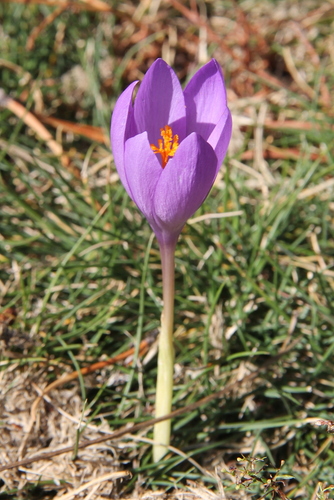Autumn Crocus
Search
Wikipedia
| Crocus nudiflorus | |
|---|---|

| |
|
Scientific classification | |
| Kingdom: | Plantae |
| Clade: | Tracheophytes |
| Clade: | Angiosperms |
| Clade: | Monocots |
| Order: | Asparagales |
| Family: | Iridaceae |
| Genus: | Crocus |
| Species: |
C. nudiflorus
|
| Binomial name | |
|
Crocus nudiflorus
Sm. 1798
| |
| Synonyms[1] | |
| |
Crocus nudiflorus is a species of flowering plant in the genus Crocus of the family Iridaceae. It is an autumn-flowering, dwarf, deciduous perennial found in western Europe from southwestern France to Spain. It has been cultivated since Tudor times in Great Britain,[2] where it is now naturalized.[3]
Description
Crocus nudiflorus grows from corms,[4] which spread out into clumps of plants by stolons.[3] Each corm usually sends out one long-tubed,[4] goblet-shaped,[3] or bell-shaped flower.[5] The bloom appears in autumn,[4] or at the end of summer.[5] The colour ranges from deep purple to lilac-purple with a paler throat and bright orange or yellow stigma.[4][5][3] Then the linear, basal leaves,[4] usually with a silvery central stripe,[3] are produced in winter and spring following the autumn flowers,[4] when the fruits appear.[5]
Taxonomy
The Latin specific epithet nudiflorus means 'naked flower', in reference to the flower emerging before the leaves.[5][2]
It was published and described by James Edward Smith in 'English Botany' Volume 7 on table 491 in 1798.[1][6]
Distribution and habitat
Crocus nudiflorus is native to southwestern France and Spain.[3][7]
Habitat
It is found on roadsides, meadows and pastures.[2][3] It often grows in pastures with other crocus species including Crocus vernus subsp. albiflorus, but it is often eaten by wild boars.[5]
Uses
It has been used in folk medicine as an anti-spasmodic, as an abortive and a sedative.[5]
Culture
In 2002, it was voted by the public as the county flower of Nottinghamshire.[2][8]
References
- ^ a b "Crocus nudiflorus Sm. is an accepted name". theplantlist.org. Retrieved 18 June 2020.
- ^ a b c d Dr. Peter Jarvis The Pelagic Dictionary of Natural History of the British Isles (2020), p. 686, at Google Books
- ^ a b c d e f g "Pacific Bulb Society | Fall Blooming Crocus Two". www.pacificbulbsociety.org. Retrieved 18 June 2020.
- ^ a b c d e f "Crocus nudiflorus, autumn crocus/RHS Gardening". rhs.org.uk. Retrieved 18 June 2020.
- ^ a b c d e f g José Luis Benito Alonso Wild Flowers of Ordesa and Monte Perdido National Park (Spanish Pyrenees) 2014, p. 38, at Google Books
- ^ "Crocus nudiflorus | International Plant Names Index". ipni.org (International Plant Names Index). Retrieved 18 June 2020.
- ^ "World Checklist of Selected Plant Families: Royal Botanic Gardens, Kew". apps.kew.org. Retrieved 2016-08-12.
- ^ "Autumn Crocus". Plantlife. Retrieved 17 June 2020.
| Wikimedia Commons has media related to Crocus nudiflorus. |
